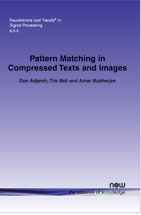Pattern Matching in Compressed Texts and Images
By Don Adjeroh, Lane Department of Computer Science and Electrical Engineering, West Virginia University, USA, don@csee.wvu.edu | Tim Bell, Department of Computer Science and Software Engineering, University of Canterbury, New Zealand, tim.bell@canterbury.ac.nz | Amar Mukherjee, School of Electrical Engineering and Computer Science, University of Central Florida, USA, amar@eecs.ecf.edu
Abstract
This review provides a survey of techniques for pattern matching in compressed text and images. Normally compressed data needs to be decompressed before it is processed, but if the compression has been done in the right way, it is often possible to search the data without having to decompress it, or at least only partially decompress it. The problem can be divided into lossless and lossy compression methods, and then in each of these cases the pattern matching can be either exact or inexact. Much work has been reported in the literature on techniques for all of these cases, including algorithms that are suitable for pattern matching for various compression methods, and compression methods designed specifically for pattern matching. This work is surveyed in this review. The review also exposes the important relationship between pattern matching and compression, and proposes some performance measures for compressed pattern matching algorithms. Ideas and directions for future work are also described.
Pattern Matching in Compressed Texts and Images
Pattern Matching in Compressed Texts and Images surveys and appraises techniques for pattern matching in compressed text and images. Normally compressed data needs to be decompressed before it is processed. If however the compression has been done in the right way, it is often possible to search the data without having to decompress it, or, at least, only partially decompress it. The problem can be divided into lossless and lossy compression methods, and then in each of these cases the pattern matching can be either exact or inexact. Much work has been reported in the literature on techniques for all of these cases. It includes algorithms that are suitable for pattern matching for various compression methods, and compression methods designed specifically for pattern matching. This monograph provides a survey of this work while also identifying the important relationship between pattern matching and compression, and proposing some performance measures for compressed pattern matching algorithms.
Pattern Matching in Compressed Texts and Images is an excellent reference text for anyone who has an interest in the problem of searching compressed text and images. It concludes with a particularly insightful section on the ideas and research directions that are likely to occupy researchers in this field in the short and long term
